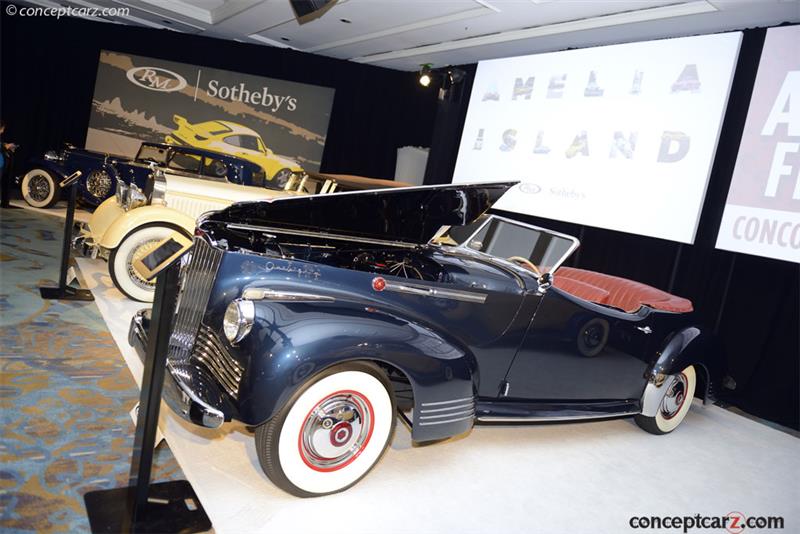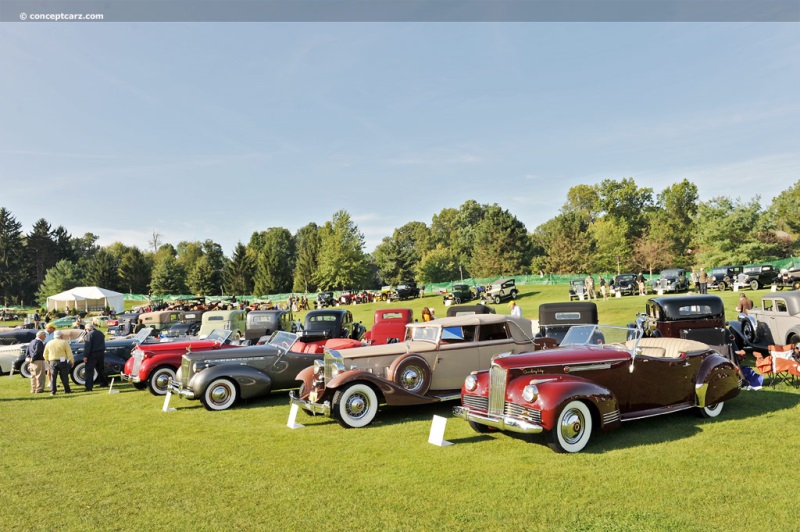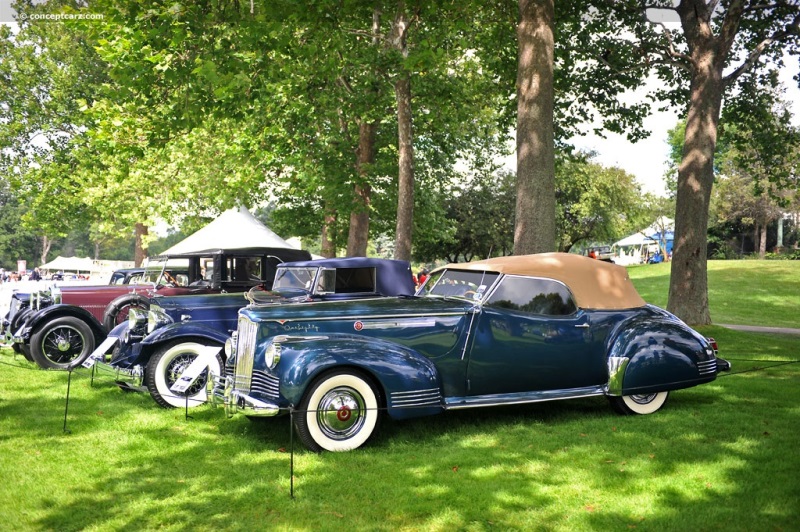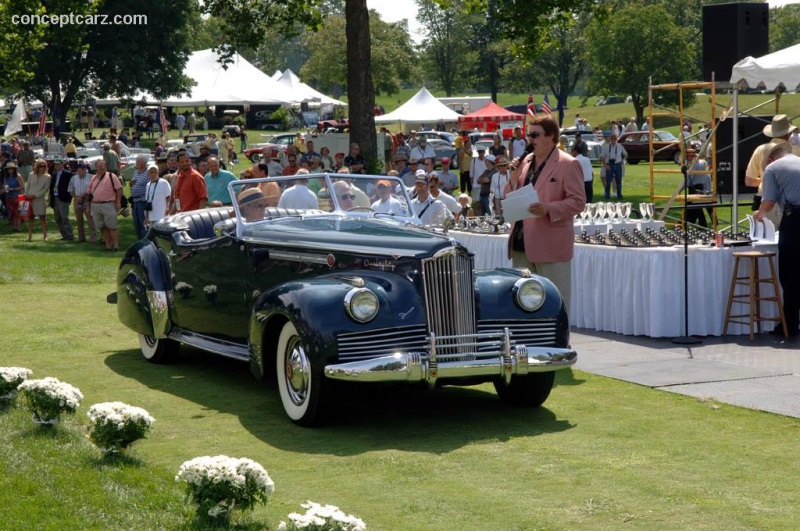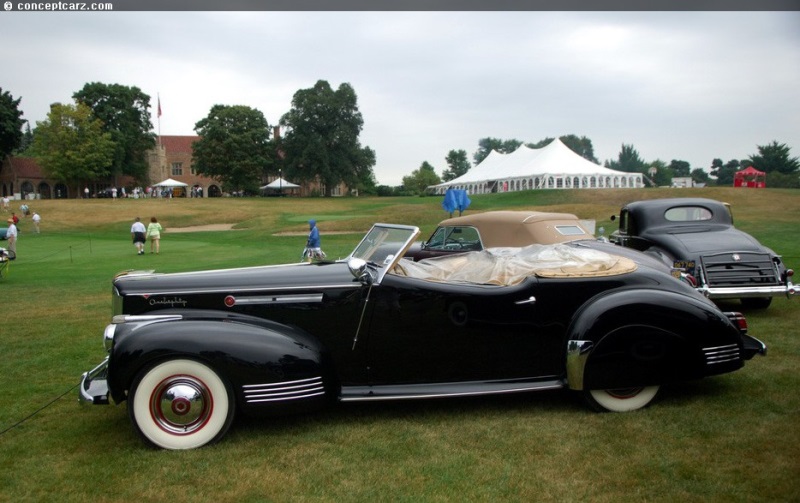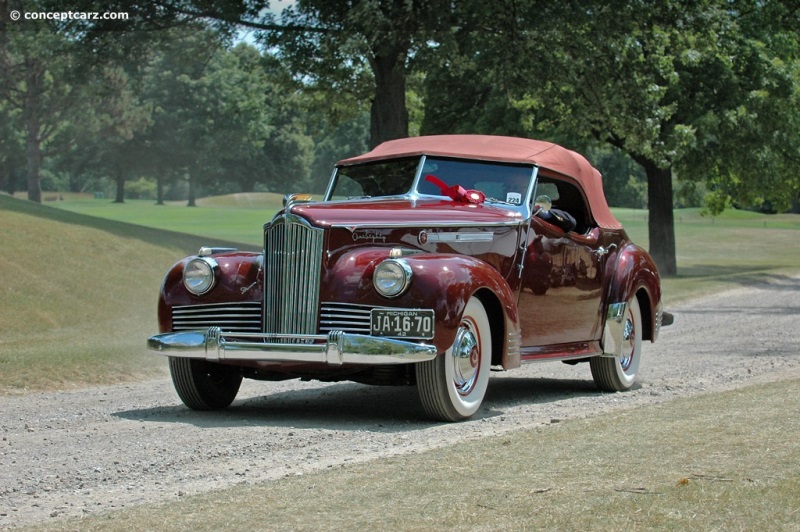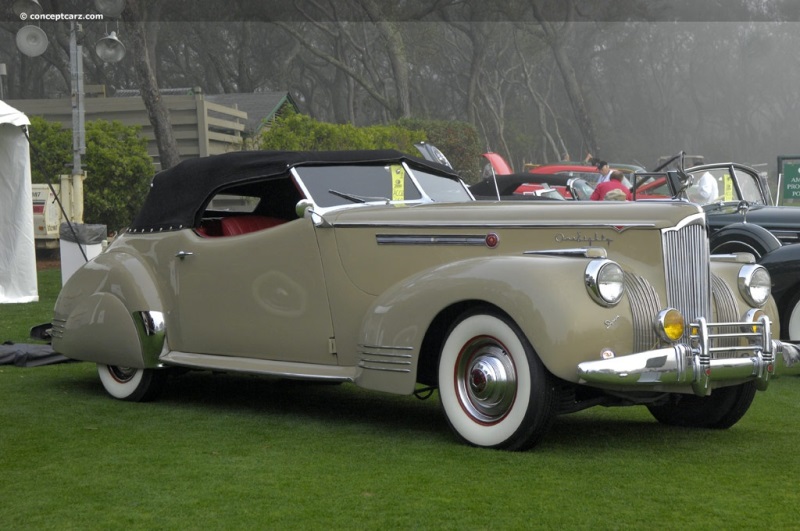The 1920s and 1930s were a roller-coaster of hardship and prosperity. The early 1920s endured a sharp deflationary recession brought on by the fluctuations of the post-World War I era as the economy shifted from wartime to peacetime production, complicated by the absorption of millions of veterans into the economy. The late 1920s saw economic growth of over forty percent and the United States produced nearly half the world's output due to the devastation caused by World War I on European factories. As the world entered the 1930s, the prosperity of the late 1920s was exchanged with the Stock Market Crash and the Great Depression. Fortunes were lost; jobs were scarce, and many automobile manufacturers were forced out of business. By the end of the 1930s, the economy was well on the road to prosperity once again.
Convertible Coupe by Darrin
View info and historyPackard had weathered the economic hardships due to its strong financial position going into the Depression and with the introduction of a lower-priced model that was more obtainable by a wider audience of buyers. This 'Junior' model was built to the same build quality as its 'Senior' model, with many mechanical and visual similarities shared between the two. The paragon of the Packard marque was its twelve-cylinder model, produced from 1932 through 1939 in very exclusive numbers. Packard's lineup as it entered the 1940s included the affordable Six (six-cylinder model) and a selection of eight-cylinder models in varying degrees of prestige. The eight-cylinder unit powering the One-Twenty displaced 282 cubic inches and delivered 120 horsepower. Its wheelbase measured 127 inches which were slightly larger than the 122 inches of the One-Ten Six, and identical to the Super-8 One-Sixty Series 1803. The Super-8 One-Sixty was also offered with a 138- and 148-inch wheelbase. The 356 cubic-inch straight-8 engine delivered 160 horsepower at 3,200 RPM and was the same unit powering the Super-8 One-Eighty, which also used a 127-, 138, and 148-inch wheelbase. As a successor to the Twelve, the One-Eighty received a higher level of trim, accouterments, luxury, and appointments. Additionally, it was the model that received the custom coachwork in the Senior line, courtesy of Howard 'Dutch' Darrin and Rollson. Packard introduced the Clipper line in 1941 using the engine from the One-Twenty (albeit with a new compression ratio that resulted in five additional horsepower), a 127-inch wheelbase, and wearing an all-new and modern appearance which was later applied throughout the line. It was offered solely as a five-passenger Touring Sedan priced below the Super-8 One-Sixty and in similar territory as the One-Twenty. 1942 Packard
Civilian automobile production was brief for 1942, lasting only a few months before factories began producing products to support the United States' involvement in World War II, prompted by the December 7th attack on Pearl Harbor. Packard's Twentieth Series of vehicles were introduced in August of 1941 and built through early 1942, with the final Packard rolling off the assembly line in Detroit on February 9th.
Convertible Coupe by Darrin
Chassis #: 15292 013
View info and history
Auction entries : 1The 'entry-level' Packard was the Six, formerly called the One-Ten and resting on a 120-, 122-, and 133-inch wheelbase. The Clipper engine and styling were used on most 1942 Packard models, including the Six. Only the Series 2020 convertible Coupe (Six) and the Series 2030 taxi (Six) continued to wear the traditional One-Ten appearance. The inline-6 cylinder engine displaced 245 horsepower and produced 105 horsepower at 3,600 RPM. Prices ranged from the mid-$1200s to nearly $1,500. The former One-Twenty was now the Packard Eight offered with a 120- or 127-inch wheelbase and powered by a 282 cubic-inch straight-eight delivering 125 horsepower. Prices ranged from $1,300 to $1,580. The Super-8 One-Sixty and the range-topping Super-8 One-Eighty rested on a 127-, 138-, and 148-inch wheelbase. The 356 cubic-inch L-head straight-8 engine had nine main bearings, hydraulic valve lifters, a 6.85:1 compression ratio, and delivered 165 horsepower at 3,600 RPM. It was backed by a three-speed selective synchromesh transmission with a column-mounted gearshift control and a single plate clutch. Hydraulic brakes operating on four wheels provided the stopping power. Prices on the One-Sixty ranged from $1,635 to $2,025. The One-Eighty prices ranged from $2,115 to $5,000. 
Convertible Coupe by Darrin
Chassis #: 15292 013
View info and history
Auction entries : 1Styling and mechanical changes for 1942 on Packard's senior models were similar to those incorporated into the Junior line. The dish-shaped wheel covers were devoid of the Packard name this year. The convertible coupe of the One-Sixty wore traditional styling while the club sedan and touring sedan wore 'Clipper' styling. Cars built atop the 138- and 148-inch wheelbase continued to wear traditional styling, albeit with minor 'Clipper' updates that included the horizontal slats of the grilles flanking the radiator. Clipper styling on the One-Eighty line was applied to the two body styles resting on the 127-inch platform - the Club Sedan priced at $2,115 and the Touring Sedan at $2,215. A Convertible Victoria with coachwork by Darrin also rested on the 127-inch wheelbase and was priced at $4,600. The Darrin-bodied Sport Sedan and the LeBaron Sport Brougham were no longer part of the body style catalog. LeBaron coachwork included a seven-passenger touring sedan ($5,545) and a Touring Limousine ($5,800), both built atop a 148-inch wheelbase. The All-Weather Cabriolet by Rollston ($4,875) rested on the 138-inch wheelbase and the All-Weather Town Car ($,975) was built on the large 148-inch wheelbase. A formal sedan ($3,050) and Touring Sedan ($2,465) used the 138-inch wheelbase and a touring sedan ($2,550) and touring limousine ($2,675) used the 148-inch platform. Howard 'Dutch' Darrin
Howard Darrin was born in 1897 in Cranford, New Jersey who later became an American World War I fighting ace, designer, inventor, and entrepreneur. He was fascinated by automobiles and in 1923, he and fellow American Thomas Hibbard sailed for Paris to help a New York Minerva distributorship establish a relationship with Hispano-Suiza. Soon, they established Hibbard & Darrin with offices on the Champs-Élysées, and, until 1929, created coachbuilt motorcars for many of the world's elite.
Convertible Coupe by Darrin
Chassis #: 15292 013
View info and history
Auction entries : 1Darrin met J. Fernandez in 1931, a Parisian banker interested in coach-building and backed by financial means to support Darrin's work. Carrosserie Fernandez & Darrin was formed and produced coachwork for the next several years. In 1937, Darrin moved back to the United States to capitalize on his Hollywood connections. At the time, Packard was building elegant coachwork on their durable platform but lacked body styles that contained flashy and flamboyant features that many Hollywood elites preferred. He soon began modifying Packards with bodies of his own design, incorporating curvaceous coachwork, vee'd windshields, a low hood line, bucket seats, and padded dashboards. Victoria body styles were given the 'Darrin Dip' cut-down doors which would become a hallmark of Darrin styling. Darrin built 15 Victorias for the 1942 model year on the Super-8 One-Eighty chassis and 35 examples the previous year. These cars were essentially hand-built to individual customer order. Over a three-year period, from 1940 through 1942, approximately 100 examples of the Darrin-styled Convertible Victoria were built. Bodies were initially built by the Auburn Central Company, the former manufacturer of Auburn cars. However, by 1941 they had a contract to build Jeep bodies for the military and couldn't build the low-volume Darrin bodies. Picking up the contract was Sayer and Scoville of Cincinnati, a builder of professional cars and limousines. By 1942, they had become Hess and Eisenhardt and had instituted some small design changes to the cars.
by Daniel Vaughan | Nov 2021
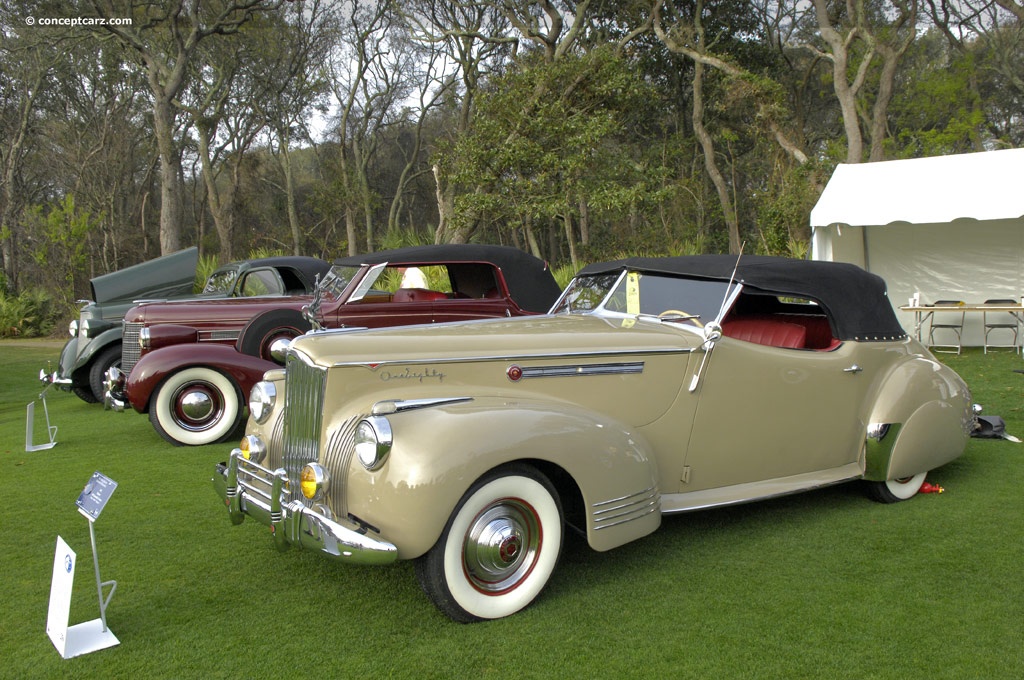
Convertible Coupe by Darrin
View info and history
Civilian automobile production was brief for 1942, lasting only a few months before factories began producing products to support the United States' involvement in World War II, prompted by the December 7th attack on Pearl Harbor. Packard's Twentieth Series of vehicles were introduced in August of 1941 and built through early 1942, with the final Packard rolling off the assembly line in Detroit on February 9th.
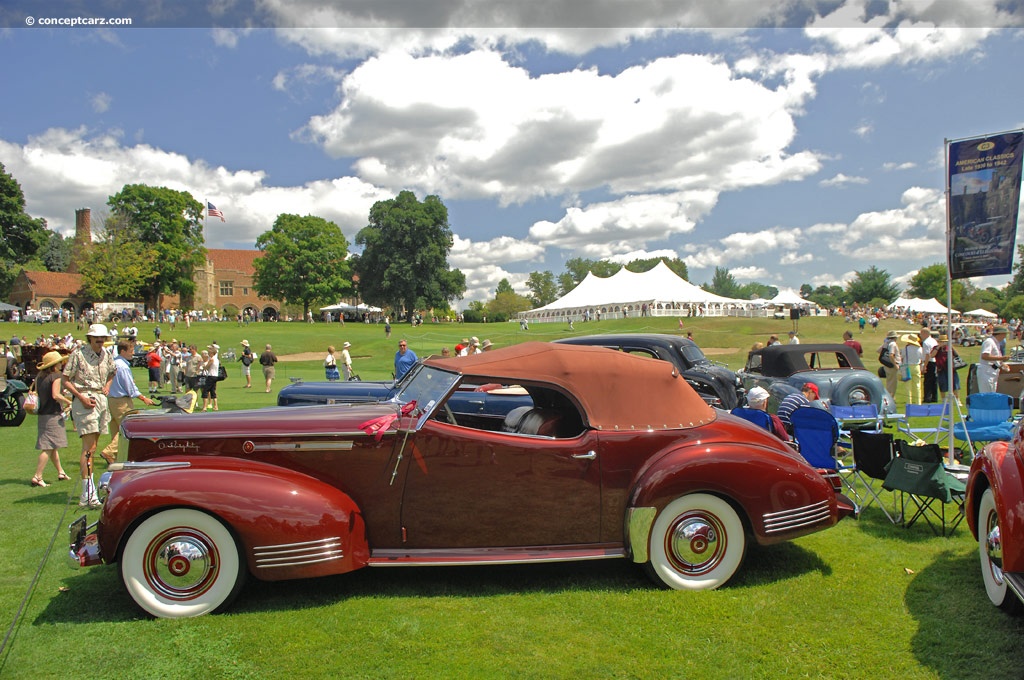
Convertible Coupe by Darrin
Chassis #: 15292 013
View info and history
Auction entries : 1
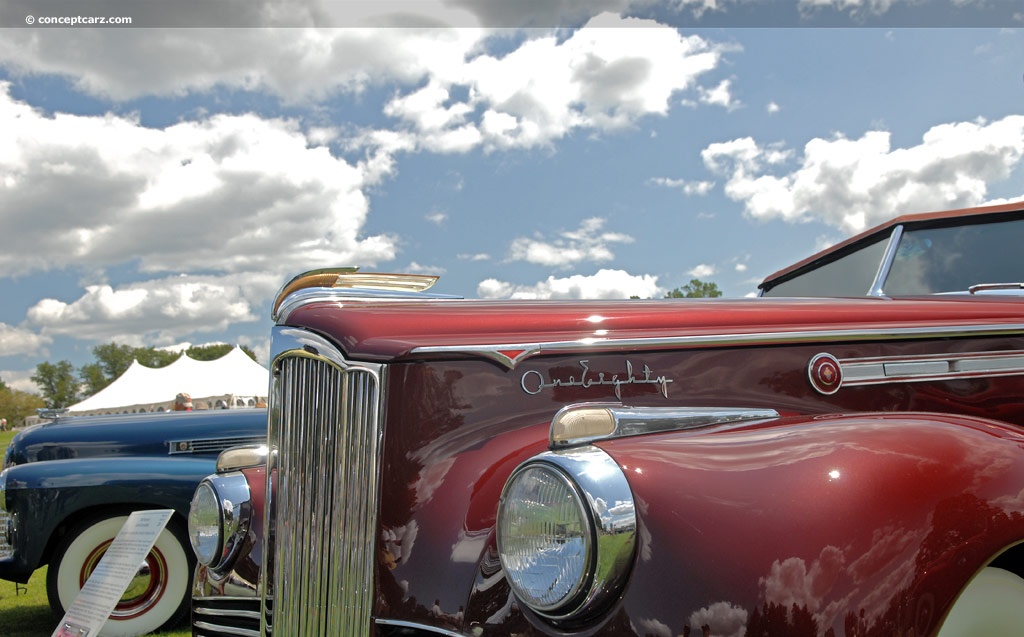
Convertible Coupe by Darrin
Chassis #: 15292 013
View info and history
Auction entries : 1
Howard Darrin was born in 1897 in Cranford, New Jersey who later became an American World War I fighting ace, designer, inventor, and entrepreneur. He was fascinated by automobiles and in 1923, he and fellow American Thomas Hibbard sailed for Paris to help a New York Minerva distributorship establish a relationship with Hispano-Suiza. Soon, they established Hibbard & Darrin with offices on the Champs-Élysées, and, until 1929, created coachbuilt motorcars for many of the world's elite.
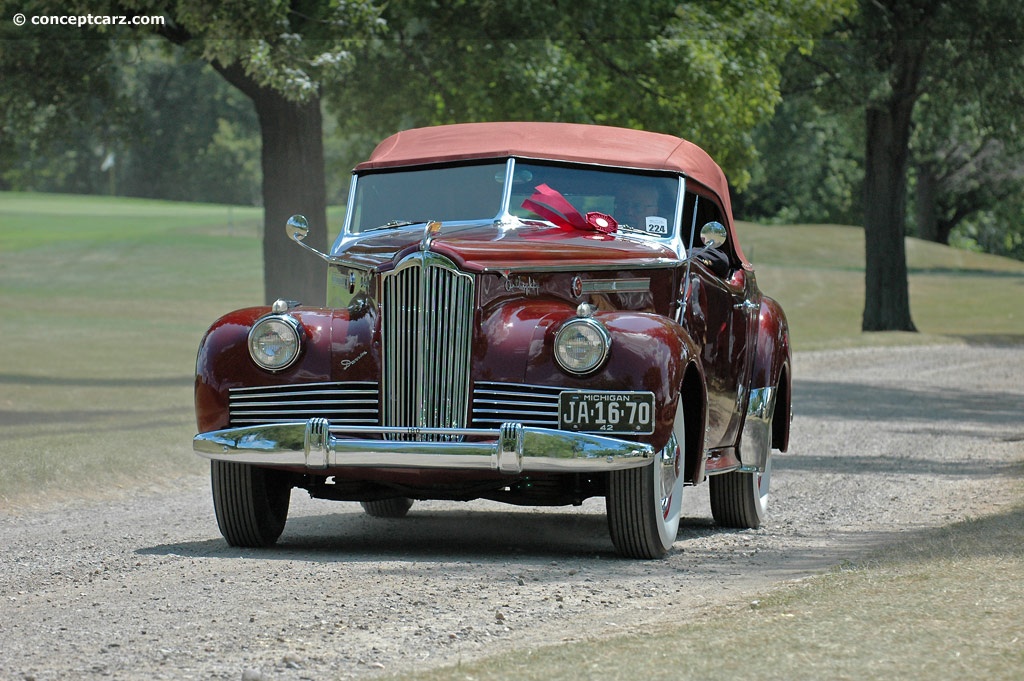
Convertible Coupe by Darrin
Chassis #: 15292 013
View info and history
Auction entries : 1
by Daniel Vaughan | Nov 2021
Related Reading : Packard Clipper History
When the Packard Company began automobile production in 1899, it was known as Ohio Automobile Company. In 1903 the name was changed to the Packard Motor Car Company when it moved from Warren, Ohio to Detroit, Michigan. The move was the result of a majority stock purchase made by investors in the Detroit area. Packard had sustained a Great Depression and a World War and was still at the fore-front....
Continue Reading >>
Continue Reading >>
Similar Automakers
1942 Packard Super-8 One-Eighty Vehicle Profiles
Recent Vehicle Additions
Performance and Specification Comparison
Price Comparison
$1,248 - $1,475
$1,300 - $1,575
$1,600 - $2,205
Clipper Specification Comparison by Year
Year
Production
Wheelbase
Engine
Prices
672
127.00 in., 138.00 in., 148.00 in.
8 cyl., 356.00 CID., 165.00hp
$2,100 - $5,795
2,763
127.00 in., 148.00 in.
8 cyl., 356.00 CID., 165.00hp
$2,910 - $4,500
7,480
127.00 in., 148.00 in.
8 cyl., 356.00 CID., 165.00hp
$3,145 - $4,520
38,804
127.00 in.
8 cyl., 282.00 CID., 125.00hp
8 cyl., 356.00 CID., 165.00hp
8 cyl., 356.00 CID., 165.00hp
$1,700 - $2,150
Related Automotive News

Past Best of Show Winners at The Pebble Beach Concours d'Elegance
overview1
The 70th anniversary of the Pebble Beach Concours dElegance was celebrated with a spectacular display of previous Best of Show winners. Thirty-seven examples graced the showfield and many were still with the same owners who raised the trophy...

1938 Mercedes-Benz 540K Autobahn Kurier Named Best of Show at the 70th Pebble Beach Concours d'Elegance
Long recognized as a superlative showcase of automotive history, the Pebble Beach Concours dElegance made history of its own at the culmination of its 70th celebration a total of 38 former Best of Show cars were on hand to welcome a new winner to their...

Alfa Romeo Named Best of Show at the 68th Pebble Beach Concours d'Elegance
Touring-Bodied Alfa Romeo 8C 2900B Named Best of Show at the 68th Pebble Beach Concours dElegance
PEBBLE BEACH, Calif. (August 26, 2018) — After an intense competition that drew diverse cars from around the globe, the coveted gold Best of Show...

1929 Mercedes-Benz S Barker Tourer Named Best Of Show At The 67Th Pebble Beach Concours d'Elegance
PEBBLE BEACH, Calif. (August 20, 2017) — Just a week ago, Bruce R. McCaws 1929 Mercedes-Benz S Barker Tourer emerged from the restoration shop of Steve Babinsky in Lebanon, New Jersey. Today, having crossed the country, the boattailed beauty captured...

Two Best of Show Winners : Similar Designs : Same Owner
When these two vehicles won Best of Show honors at major Concours dElegance events, they both were owned by Judge Joseph Cassini III. The green colored Chrysler 4 door Phaeton with tan convertible top wears coachwork by LeBaron. In 2012, it won the...



























